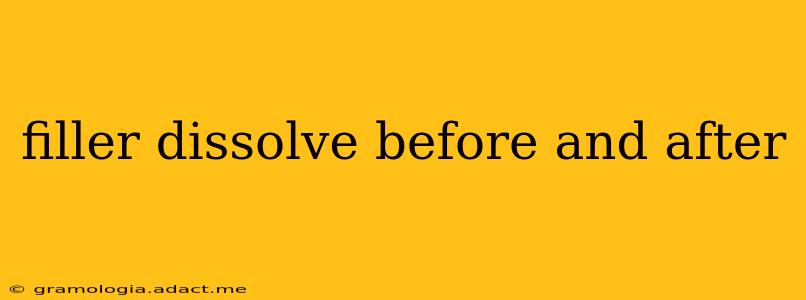Dermal fillers are a popular non-surgical cosmetic treatment used to enhance facial features, plump up lips, and reduce wrinkles. While generally safe and effective, understanding the potential for filler dissolution – both the process and the results – is crucial before undergoing the procedure. This comprehensive guide explores the before-and-after aspects of filler dissolution, addressing common concerns and providing valuable insights.
What is Filler Dissolution?
Filler dissolution refers to the process of reversing the effects of dermal fillers. Fillers are injected substances, often hyaluronic acid-based, that add volume and fullness to the face. Dissolution is necessary when a patient is unhappy with the results, experiences complications like migration or asymmetry, or needs to remove the filler before another procedure. The process typically involves injecting a substance called hyaluronidase, an enzyme that breaks down hyaluronic acid fillers.
Before Filler Dissolution: What to Expect
Before undergoing filler dissolution, a thorough consultation with a qualified and experienced dermatologist or plastic surgeon is essential. This consultation will involve:
- Medical history review: The doctor will assess your overall health, allergies, and any existing medical conditions to determine your suitability for the procedure.
- Examination of the filler: The doctor will evaluate the type and location of the filler to determine the best course of action for dissolution.
- Discussion of expectations and risks: A realistic discussion about the procedure's outcome, potential side effects, and recovery time is crucial.
- Allergy testing (if necessary): In rare cases, an allergy test may be conducted to check for hypersensitivity to hyaluronidase.
The Filler Dissolution Procedure Itself
The procedure itself is relatively straightforward. The doctor will inject hyaluronidase into the area containing the filler. The enzyme gradually breaks down the hyaluronic acid, causing the filler to dissolve. The process is typically minimally invasive and performed in a clinic setting. The amount of hyaluronidase used will depend on the volume and type of filler needing dissolution.
After Filler Dissolution: Recovery and Results
Following the procedure, you might experience some mild side effects, such as:
- Swelling: Swelling is common and usually subsides within a few days.
- Bruising: Minor bruising is possible at the injection site.
- Redness: Redness may occur, gradually fading over time.
- Itching or discomfort: Mild itching or discomfort is also possible.
These side effects are usually temporary and manageable with ice packs and over-the-counter pain relievers. The complete dissolution of the filler can take a few days to a couple of weeks, depending on the amount of filler and individual factors. The results are gradual, not immediate, which allows for better control and a more natural look.
How Long Does Filler Dissolution Take?
The time it takes for a filler to completely dissolve varies greatly depending on several factors:
- Type of filler: Different fillers dissolve at different rates.
- Amount of filler: Larger volumes of filler take longer to dissolve.
- Individual metabolism: Metabolic rate influences how quickly the body processes the hyaluronidase.
- Injection technique: The method of injection can affect the dissolution process.
While some may see results within a day or two, complete dissolution might take up to two weeks or longer.
What are the Risks of Filler Dissolution?
While generally safe, filler dissolution carries some potential risks, including:
- Allergic reactions: Allergic reactions to hyaluronidase are rare but possible.
- Infection: Infection is a rare complication, but proper sterilization techniques help minimize this risk.
- Uneven dissolution: In some cases, the filler may dissolve unevenly, requiring additional treatments.
- Hypersensitivity: Some individuals may exhibit hypersensitivity to the injected enzyme.
Choosing an experienced and qualified practitioner significantly reduces these risks.
Can you dissolve all types of fillers?
No, hyaluronidase only dissolves hyaluronic acid-based fillers. Other types of fillers, such as those made from calcium hydroxylapatite or poly-L-lactic acid, require different methods for removal or will naturally degrade over time.
Is Filler Dissolution Painful?
Most patients report minimal discomfort during the procedure. A topical anesthetic cream may be applied to numb the area beforehand, reducing any sensation. Post-procedure discomfort is usually mild and manageable with ice packs and over-the-counter pain relief medication.
How Much Does Filler Dissolution Cost?
The cost of filler dissolution varies depending on the amount of filler needing removal, the location of the treatment, and the practitioner’s fees. It’s best to discuss pricing directly with your chosen clinic or dermatologist.
By understanding the before-and-after aspects of filler dissolution, you can make informed decisions and manage expectations appropriately. Remember, a thorough consultation with a qualified professional is paramount for a safe and successful outcome.
